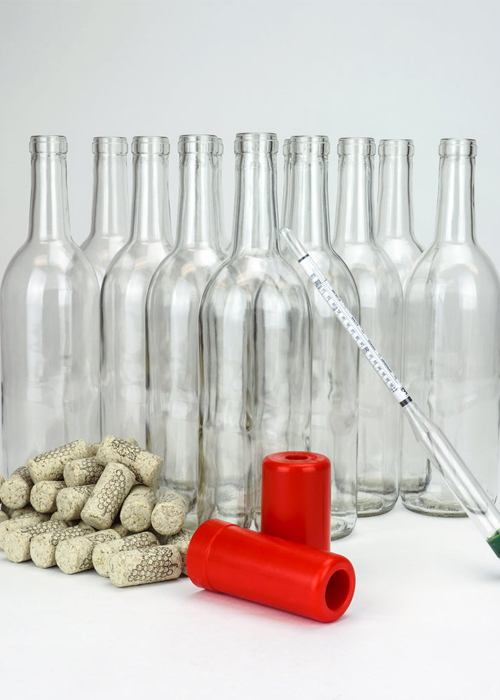It isn’t necessary to own a vineyard in California or Tuscany, or even live near one, to make wine from grapes grown in these famous terroirs. Each fall, amateur winemakers descend on specialized markets in a few major cities, especially on the East Coast, to purchase grapes arriving in refrigerated containers from these and other well-regarded regions.
One such amateur vintner, Vince Paladino, regional manager for a construction firm, gets the urge each fall to smell ripe grapes and make a fresh batch of homemade wine. When that happens, he drives from his home outside Harrisburg, Pa., the 140 miles to Hammonton, N.J., to buy grapes at the Gino Pinto store for winemakers. A couple of vintages ago, Paladino headed his truck back to Pennsylvania with 380 pounds of red grapes picked only a few days earlier in northern Italy.
“My neighbor and I took from 3 p.m. that evening until 4:30 the next morning to de-stem the grapes,” Paladino says. For their toil, each man was putting his own labels on a few dozen bottles of homemade Piemonte wine just a few months later.
Although grape juice and must (crushed grapes and juice) are available year-round for making wine in the family garage, basement, or apartment closet, home winemakers get especially excited about making wine locally from grapes grown in faraway places. Their sources are family-run markets in cities such as Boston, New York, Philadelphia, and Chicago that for years have supplied winemaking families, many whose parents or grandparents traditionally made wine in Eastern or Southern Europe before arriving in the U.S.
Alternatively for fresh grape lovers, most states have local wineries or independent vineyards that sell grapes to amateur winemakers, and some even offer pick-your-own grapes. A third alternative for those who don’t want to pick or shop in person is West Coast grape brokers who directly ship a variety of refrigerated or frozen grapes.
Grape must and juice are also available for those without the time or space to deal with actual grapes, as are complete winemaking kits that come with juice or concentrate, winemaking instructions, and all the gear and chemicals needed to ferment juice into wine, then stabilize, sanitize, and bottle it.
But starting with actual grapes is more fun — especially for those who share winemaking as a joint project with family and friends. “During September and October, we have 36-pound boxes of grapes of just about every variety of grapes you would want,” says Gino Pinto’s Michael Pinto, “which will translate into two and a half to three gallons of wine. But quite often, a group will get together and make 30 gallons among them.” Cabernet Sauvignon is the top seller, Pinto says. “Everything else battles for second.”
As sourcing grapes is now an international business, Pinto and other brokers also have grapes to sell each spring when shipments arrive from South Africa, South America, and other wine regions in the Southern Hemisphere.

Dennis Karas, owner of Santa Fe Grapes Distributors on Chicago’s South Side, says: “My father-in-law started the grape business in 1924. Back then, during Prohibition, the Gallos would take the train from California each fall to sell grapes to home winemakers.” Each autumn, Karas still sets up shop in a parking lot at 3500 S. Racine St. “Muscat is our most popular variety,” he says, “but we also sell a lot of Zinfandel, Cabernet, and Merlot.”
Other traditional wine grape brokers include M. Cuttone Wine Grapes in Chelsea, Mass., just outside of Boston, Procacci Brothers in South Philadelphia, and TP&S Winegrapes in the Brooklyn Terminal Market. At the latter, a typical price for 36 pounds of Barbera grapes is $54.
Mitchell Vineyards in Oregon, Wis., just south of Madison, has been offering pick-your-own grapes for winemakers since 1976 and has 12 different hybrid and native grape varieties from which to choose. “We provide picking containers and shears for our customers, and we can also de-stem and crush their red grapes and press the juice for white grapes,” says owner David Mitchell. “We have people coming from Chicago, even Indiana, and some will pick over 1,000 pounds.”
In northwestern New York State, wineries and vineyards in the Finger Lakes area provide fresh grapes and juice from cool-weather varieties such as Riesling and Gewürztraminer. “For example, Fulkerson Winery offers fresh-pressed grape juice and custom-crushed red grapes to home winemakers,” says Brittany Gibson, executive director of Seneca Lake Wine Trail. “Not only is this a lot of fun, a neat hobby, and a great learning process; it helps maintain a connection to the land and the centuries-old art of winemaking.”
Online grape and must providers include Grapemust.com, which sells a six-gallon pail of California Cabernet Sauvignon for $120, and Grapes for Wine, which offers a six-gallon container of Livermore, Calif., Pinot Noir for $130. Midwest Supplies offers a complete, six-gallon wine kit with Sauvignon Blanc juice for $91, among dozens of other options.
“I recommend that beginners consider taking a winemaking class,” says Hammonton’s Pinto. “It may cost you $1,000 or so, but that’s not a lot for a lifetime hobby — plus, you get to take home wine after class.” Of course, YouTube and other sites also offer plenty of how-to videos for amateur vintners.
David Falchek, executive director of the American Wine Society, says part of the organization’s mission is to “help improve the craft of winemaking for both amateur and professional winemakers.” The society’s amateur winemaking competition is, according to Falchek, the oldest in the country and annually draws over 1,000 entries. “More than 100 of our members have gone on to become commercial winemakers,” he notes.
Highly regarded winemaker Antony Vietri of Va La Family Farmed Wines in Avondale, Pa., learned winemaking the old-fashioned way. “Beginning in the late 1920s, our family had an arrangement with a vineyard in Rancho Cucamonga, Calif., for Zinfandel and Barbera grapes to be shipped to us every year,” he says. “The grapes would come by train to the station here in Avondale, and I still remember the family using every available vehicle and animal to haul all the grapes back to the farm to make wine.” After a career in the film industry, Vietri and his wife Karen returned to the family farm to open their own winery in 2001.
“The two keys to successful home winemaking are cleanliness and punctuality,” advises Paladino. “If you aren’t clean, then bad things can happen to your wine. Additionally, if you are going to make good wine, you have to be ready to take care of it when it’s ready — even if it isn’t convenient.” This includes racking and adding chemicals when the wine is ready.
Finally, individual creativity often goes beyond turning grapes into wine. Finding a name and designing a label for a new vintner’s freshly bottled vino opens up a whole new realm of artistic possibilities. For those who need a little help, companies such as Evermine Labels and Zazzle offer traditional and humorous templates for dropping in personalized wording. Best of all, as the wine isn’t being sold — unlike at professional wineries — all that’s left to do is pop the cork and enjoy your creation.
